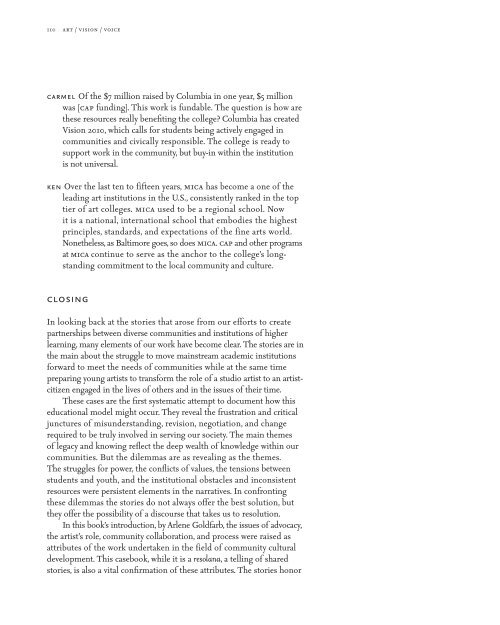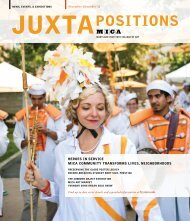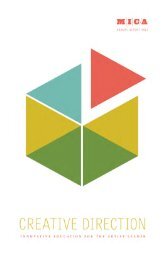art/vision/voice - Maryland Institute College of Art
art/vision/voice - Maryland Institute College of Art
art/vision/voice - Maryland Institute College of Art
Create successful ePaper yourself
Turn your PDF publications into a flip-book with our unique Google optimized e-Paper software.
110 <strong>art</strong> / <strong>vision</strong> / <strong>voice</strong><br />
carmel Of the $7 million raised by Columbia in one year, $5 million<br />
was [cap funding]. This work is fundable. The question is how are<br />
these resources really benefiting the college? Columbia has created<br />
Vision 2010, which calls for students being actively engaged in<br />
communities and civically responsible. The college is ready to<br />
support work in the community, but buy-in within the institution<br />
is not universal.<br />
ken Over the last ten to fifteen years, mica has become a one <strong>of</strong> the<br />
leading <strong>art</strong> institutions in the U.S., consistently ranked in the top<br />
tier <strong>of</strong> <strong>art</strong> colleges. mica used to be a regional school. Now<br />
it is a national, international school that embodies the highest<br />
principles, standards, and expectations <strong>of</strong> the fine <strong>art</strong>s world.<br />
Nonetheless, as Baltimore goes, so does mica. cap and other programs<br />
at mica continue to serve as the anchor to the college’s longstanding<br />
commitment to the local community and culture.<br />
closing<br />
In looking back at the stories that arose from our efforts to create<br />
p<strong>art</strong>nerships between diverse communities and institutions <strong>of</strong> higher<br />
learning, many elements <strong>of</strong> our work have become clear. The stories are in<br />
the main about the struggle to move mainstream academic institutions<br />
forward to meet the needs <strong>of</strong> communities while at the same time<br />
preparing young <strong>art</strong>ists to transform the role <strong>of</strong> a studio <strong>art</strong>ist to an <strong>art</strong>istcitizen<br />
engaged in the lives <strong>of</strong> others and in the issues <strong>of</strong> their time.<br />
These cases are the first systematic attempt to document how this<br />
educational model might occur. They reveal the frustration and critical<br />
junctures <strong>of</strong> misunderstanding, re<strong>vision</strong>, negotiation, and change<br />
required to be truly involved in serving our society. The main themes<br />
<strong>of</strong> legacy and knowing reflect the deep wealth <strong>of</strong> knowledge within our<br />
communities. But the dilemmas are as revealing as the themes.<br />
The struggles for power, the conflicts <strong>of</strong> values, the tensions between<br />
students and youth, and the institutional obstacles and inconsistent<br />
resources were persistent elements in the narratives. In confronting<br />
these dilemmas the stories do not always <strong>of</strong>fer the best solution, but<br />
they <strong>of</strong>fer the possibility <strong>of</strong> a discourse that takes us to resolution.<br />
In this book’s introduction, by Arlene Goldfarb, the issues <strong>of</strong> advocacy,<br />
the <strong>art</strong>ist’s role, community collaboration, and process were raised as<br />
attributes <strong>of</strong> the work undertaken in the field <strong>of</strong> community cultural<br />
development. This casebook, while it is a resolana, a telling <strong>of</strong> shared<br />
stories, is also a vital confirmation <strong>of</strong> these attributes. The stories honor
















